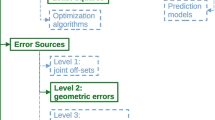Abstract
Typical approaches to calibrate industrial robots are based on open- and closed-loop methods; the screw–axis measurement methods traditionally receive much less attention. Although the identification process does not guarantee the physical–mathematical link between the robot parameters in the first two groups of techniques, these techniques are generally more effective in reducing the global positioning error compared to the screw–axis methods. The third group of techniques acquires parameters based on the physical reality of the robot, effectively keeping the physical–mathematical link. This group is considered more appropriate than the previous two groups; however, it cannot reduce the overall error when considering the entire workspace of the robot compared to the previous groups. This paper presents a new technique to identify the kinematic parameters of an industrial robot based on a combination of techniques from the aforementioned categories. This new data acquisition technique uses a laser tracker with an active target, which maximises the angle covered by each joint and greatly simplifies the screw–axis measurement process. An identification procedure based on circle point analysis is also proposed, and the procedure evaluates the technique by obtaining initial values with a new formulation of the objective function of error based on mutual distances between the points captured in screw–axis measurements. This type of measurement also allows the eccentricity and backlash of each joint to be characterised independently such that local joint corrections could be made in combination with the identified parameters.
Similar content being viewed by others
References
Sheth PN, Uicket JJ (1971) A generalized symbolic notation of mechanism. ASME J Eng Ind 102–112
Caenen JL, Angue JC (1990) Identification of geometric and non-geometric parameters of robots. Proc IEEE Int Conf Robot Autom 2:1032–1037
Everett LJ, Suryohadiprojo AH (1988) A study of kinematic models for forward calibration of manipulators. Proc IEEE Int Conf Robot Autom 798–800
Park FC, Brockett RW (1994) Kinematic dexterity of robotic mechanisms. Int J Robot Res 13(1):1–15
Drouet PH, Dubowsky S, Zeghloul S, Mavroidis C (2002) Compensation of geometric and elastic errors in large manipulators with an application to a high accuracy medical system. Robotica 20(3):341–352
Roth ZS, Mooring BW, Ravani B (1987) An overview of robot calibration. IEEE J Robot Autom RA-3(5):377–385
Denavit J, Hartenberg RS (1955) A kinematic notation for lower-pair mechanisms based on matrices. J Appl Mech Trans ASME 77:215–221
Hollerbach JM, Wampler CW (1996) The calibration index and taxonomy for robot kinematic calibration methods. Int J Robot Res 15(6):573–591
Mooring BW, Roth ZS, Driels MR (1991) Fundamentals of manipulator calibration. Wiley, New York
Bennett DJ, Hollerbach JM (1991) Autonomous calibration of single-loop closed kinematic chains formed by manipulators with passive endpoint constraints. IEEE Trans Robot Autom 7(5):597–606
Stone HW (1987) Kinematic modeling, identification, and control of robotic manipulators. Kluwer Academic, Boston
Sklar ME (1989) Geometric calibration of industrial manipulators by circle point analysis. Proc 2nd Conf Recent Adv Robot 178–202
Abderrahim M, Whittaker AR (2000) Kinematic model identification of industrial manipulators. Robot Comput Integr Manuf 16:1–8
Newman WS, Birkhimer CE, Horning RJ, Wilkey AJ (2000) Calibration of a Motoman P8 robot based on laser tracking. In: Proceedings of the 2000 IEEE International Conference on Robotics and Automation, San Francisco pp. 3597–3602
Alici G, Shirinzadeh B (2005) A systematic technique to estimate positioning errors for robot accuracy improvement using laser interferometry based sensing. Mech Mach Theory 40:879–906
Newman WS, Birkhimer CE, Horning RJ (2000) Calibration of a Motoman P8 robot based on laser tracking. Proc. of the 2000 IEEE International Conference of Robotics & Automation, San Francisco
Horning RJ (1998) A comparison of identification techniques for robot calibration. Case Western Reserve University
Paul RP (1982) Robot manipulators: mathematics, programming and control. MIT, Cambridge
Kirchner HOK, Gurumoorthy B, Prinz FB (1987) A perturbation approach to robot calibration. Int J Robot Res 6:47–59
Schroer K (1993) Theory of kinematic modelling and numerical procedures for robot calibration. In: Bernhardt R, Albright S (eds) Robot calibration. Chapman Hall, London, pp 157–193
Ibarra R, Perreira ND (1986) Determination of linkage parameter and pair variable errors in open chain kinematic linkages using minimal set of pose measurement data. J Mech Transm Autom Des 159–166
Hayati SA, Mirmirani M (1985) Improving the absolute positioning accuracy of robot manipulators. J Robot Syst 2:397–413
Judd RP, Knasinski AB (1987) A technique to calibrate industrial robots with experimental verification. Proc IEEE Int Conf Robot Autom 351–357
Sugimoto K, Okada T (1985) Compensation of positioning errors caused by geometric deviations in the robot system. Robotics Research: The Second International Symposium 231–236
Horn BKP (1987) Closed-form solution of absolute orientation using unit quaternions. J Optic Soc Am 4:629
Plücker J (1865) On a new geometry of space. Phil Trans R Soc 155:725–791
Pottmann H, Peternell M, Ravani B (1999) An introduction to line geometry with applications. Comput Aided Des 31(1):3–16
Moré JJ (1977) The Levenberg–Marquardt algorithm: implementation and theory. In: Watson GA (ed) Numerical analysis. Lecture notes in Mathematics 630. Springer, Berlin, pp 105–116
Author information
Authors and Affiliations
Corresponding author
Rights and permissions
About this article
Cite this article
Santolaria, J., Conte, J. & Ginés, M. Laser tracker-based kinematic parameter calibration of industrial robots by improved CPA method and active retroreflector. Int J Adv Manuf Technol 66, 2087–2106 (2013). https://doi.org/10.1007/s00170-012-4484-6
Received:
Accepted:
Published:
Issue Date:
DOI: https://doi.org/10.1007/s00170-012-4484-6




